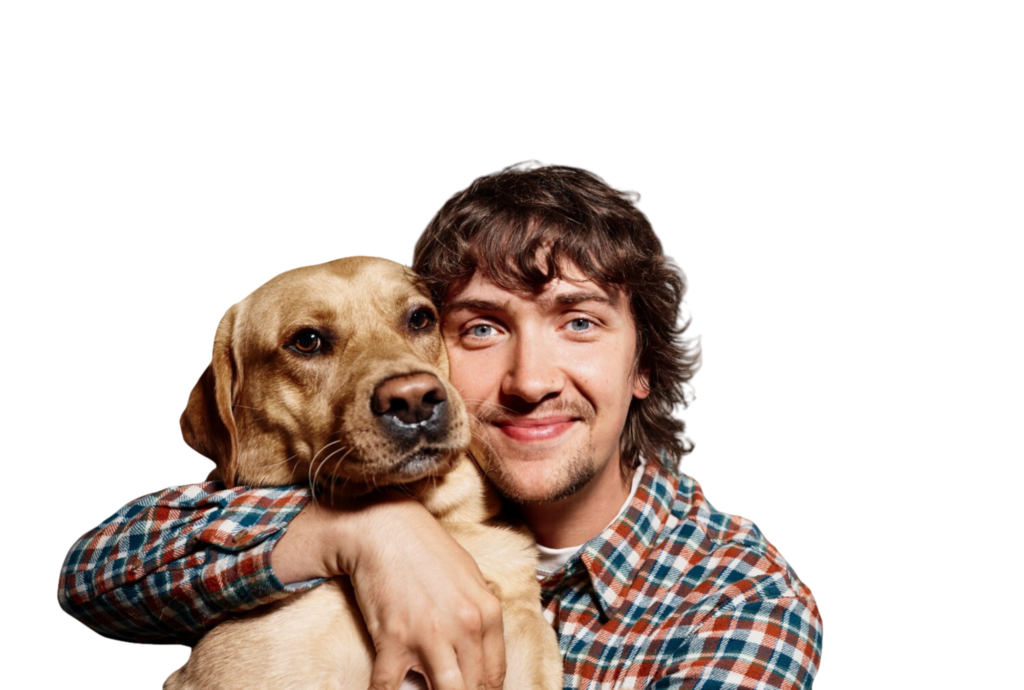Long-haired dogs are some of the most attractive and cherished pets in the dog world. These breeds have beautiful coats that show off nature’s art. The Afghan Hound has long, flowing hair, and the Cocker Spaniel has silky waves. To take good care of your dog and keep them healthy and happy, you need to know about the many kinds of long coats they have.
This comprehensive guide explores the various types of long coats, popular breeds that sport them, and essential grooming tips to keep your furry friend looking their best. At Kontota, we’re passionate about helping every dog look and feel their best, offering specialized grooming services designed to maintain the health and beauty of these magnificent coats. Whether you’re considering adopting a long-haired dog breed or already share your home with one, this information will help you provide the best care possible.
Understanding Long Coat Classifications
Long-haired dog breeds have a wide range of coat textures, lengths, and care needs. Professional groomers usually put these coats into a few different groups, each of which needs a different way to be groomed and a different plan for care.
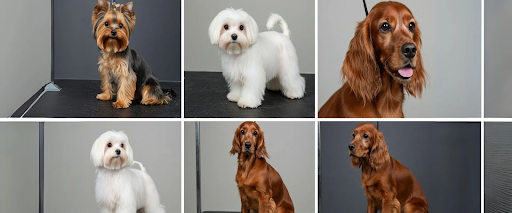
Silky Coats
Silky coats are the most elegant thing a dog can wear. These coatings feel soft to the touch and have a natural sheen that catches the light in a wonderful way. The hair strands are straight and thin, which gives it that velvety feel.
Characteristics of silky coats:
- Fine, straight hair strands
- Natural lustrous appearance
- Smooth texture when properly maintained
- Prone to tangling if not brushed regularly
- Requires gentle handling during grooming
Popular breeds with silky coats:
Common “long-haired dog breeds” with silky coats include
- Yorkshire Terrier
- Maltese
- Silky Terrier
- Cocker Spaniel
- Irish Setter
To keep their sheen and prevent matting, silky coats need to be brushed every day. These coats are quite delicate, so they can quickly get tangled, especially around the ears, legs, and belly.
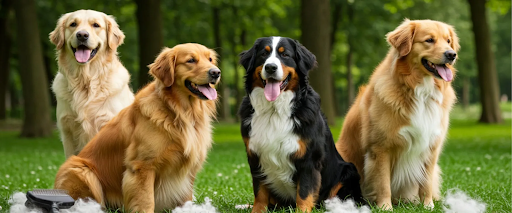
Double Coats
Many “long-haired dog breeds” possess a double coat, consisting of a soft, dense undercoat for insulation and a longer, coarser outer coat (guard hairs) for protection against the elements. The undercoat consists of soft, dense fur close to the skin, while the outer coat features longer guard hairs that repel water and debris.
Characteristics of double coats:
- Dense undercoat for insulation
- Longer guard hairs for protection
- Seasonal shedding patterns
- Excellent temperature regulation
- Water-resistant properties
Popular long-haired breeds with double coats:
- Golden Retriever
- Bernese Mountain Dog
- Newfoundland
- Great Pyrenees
- Rough Collie
Double coats require specialized grooming techniques, particularly during shedding seasons. Regular brushing helps manage loose fur and prevents matting of the undercoat.
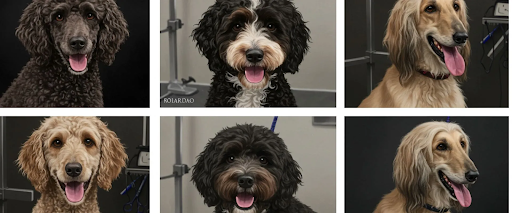
Curly and Wavy Coats
Curly and wavy coats have different textures, from loose waves to tight curls. These kinds of coats frequently feel like wool and need special grooming methods to keep their natural pattern.
Characteristics of curly and wavy coats:
- Natural curl or wave pattern
- Often hypoallergenic properties
- Wool-like texture
- Minimal shedding
- Requires regular professional grooming
Popular breeds with curly and wavy long coats:
- Poodle (Standard)
- Portuguese Water Dog
- Bichon Frise
- Curly-Coated Retriever
- Afghan Hound (wavy variety)
Regular professional grooming is good for these coats because it keeps their shape and stops them from matting. The curl pattern can disguise dirt and matting, so it’s important to groom your pet well.

Corded Coats
Corded coats are one of the most unique styles of coats because the hair naturally produces strands or cords that seem like ropes. This unusual look needs extra care and knowledge.
Characteristics of corded coats:
- Natural formation of rope-like strands
- Requires patient cord development
- Minimal brushing once cords form
- Unique appearance and texture
- Long drying time after baths
Popular breeds with corded coats:
- Komondor
- Puli
- Bergamasco Sheepdog
Corded coats need expert handling, as improper grooming can damage the cord structure. Many owners work with professional groomers who specialize in these unique coat types.
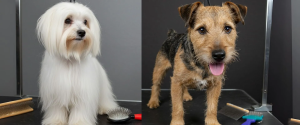
Silky vs Coarse Coats: Key Differences
Understanding the distinction between silky vs coarse coats helps owners provide appropriate care for their dogs. These two coat types require different grooming approaches, products, and maintenance schedules.
Silky Coat Characteristics
Silky coats feel smooth and luxurious to the touch. The individual hair strands are fine and reflect light beautifully, creating a glossy appearance. However, this fineness also makes them more prone to tangling and requires gentle handling.
Care requirements for silky coats:
- Daily brushing with soft-bristled brushes
- Gentle, moisturizing shampoos
- Leave-in conditioners to prevent tangles
- Regular professional grooming every 6-8 weeks
- Protection from harsh weather conditions
Coarse Coat Characteristics
Coarse coats have thicker, more robust hair strands that provide better protection from the elements. While they may not have the shine of silky coats, they’re often more durable and easier to maintain.
Care requirements for coarse coats:
- Regular brushing with firmer bristles
- Strengthening shampoos and conditioners
- Less frequent professional grooming
- More resilient to weather conditions
- May require thinning to manage bulk
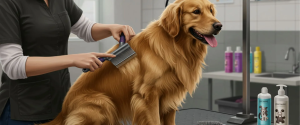
Essential Grooming Tips for All Long-Haired Dog Breeds
Grooming long coats requires patience, the right tools, and proper techniques. Regular maintenance prevents painful matting, reduces shedding, and keeps your dog comfortable and healthy.
Daily Maintenance
Daily brushing forms the foundation of long coat care. This practice prevents tangles from forming and distributes natural oils throughout the coat.
Daily grooming routine:
- Start with a wide-tooth comb to work through any tangles
- Use a slicker brush to remove loose hair
- Finish with a pin brush to smooth the coat
- Pay special attention to high-friction areas like legs and belly
- Check for any mats or foreign objects
Weekly Deep Grooming
Weekly sessions allow for more thorough grooming and health checks. This is when you can address any developing issues before they become serious problems.
Weekly grooming checklist:
- Thorough brushing of the entire coat.
- Cleaning ears and checking for infections
- Trimming nails if needed
- Brushing teeth
- Checking skin for irritations or parasites
- Trimming hair around paws and sanitary areas
Professional Grooming Schedule
Long-haired dog breeds benefit from regular professional grooming. Professional groomers have specialized tools and expertise to handle complex coat types safely and effectively.
Recommended professional grooming frequency:
- Silky coats: Every 6-8 weeks
- Double coats: Every 8-12 weeks
- Curly coats: Every 6-8 weeks
- Corded coats: As needed for cord maintenance
Common Grooming Challenges and Solutions
Long coat ownership comes with unique challenges that require specific solutions and approaches.
Matting Prevention and Removal
Mats form when loose hair becomes tangled and compressed. Prevention is always easier than removal, but when mats do occur, proper technique is essential.
Matting prevention strategies:
- Daily brushing without exception
- Use detangling sprays before brushing
- Focus on high-friction areas
- Keep your dog’s coat clean and dry
- Regular professional grooming
Safe mat removal techniques:
- Work from the outside of the mat inward
- Use a mat splitter for stubborn tangles
- Apply detangling spray liberally
- Never pull or yank on mats
- Consider professional help for severe matting
Seasonal Shedding Management
Many long-coated breeds experience seasonal shedding that requires additional attention during spring and fall.
Seasonal grooming adjustments:
- Increase brushing frequency during shedding seasons
- Use undercoat rakes for double-coated breeds
- Consider professional de-shedding treatments
- Maintain regular bathing schedules
- Vacuum living spaces more frequently
Why Professional Grooming Matters
While home grooming is essential, professional grooming services provide expertise and equipment that most pet owners lack. Professional groomers understand the specific needs of different coat types and can identify potential health issues early.
Benefits of Professional Mobile Grooming
Mobile grooming services like Kontota bring professional expertise directly to your home, providing convenience and reducing stress for both you and your pet. This service is particularly beneficial for long-coated breeds that require regular maintenance.
Advantages of mobile grooming:
- Stress-free environment for your pet
- One-on-one attention from skilled groomers
- Convenience of home service
- Professional-grade equipment and products
- Expertise in handling different coat types
For long-coated dog breeds requiring specialized care, Kontota’s mobile grooming services offer the perfect solution. Our trained professionals understand the unique needs of various coat types and provide comprehensive grooming services right at your doorstep.
Contact Kontota Today and keep Your Long-Coated Companion Happy and Healthy
Frequently Asked Questions
How often should I brush my long-coated dog?
Long-coated dogs should be brushed daily to prevent matting and maintain coat health. Some breeds with particularly fine or tangle-prone coats may need brushing twice daily, especially during shedding seasons.
Can I cut my long-coated dog’s hair myself?
While basic trimming around paws and sanitary areas can be done at home, major haircuts should be left to professional groomers. Improper cutting can damage the coat’s natural growth pattern and create uneven results.
What’s the best brush for long-coated dogs?
The best brush depends on your dog’s specific coat type. Silky coats benefit from soft pin brushes, while double coats need slicker brushes and undercoat rakes. Consult with a professional groomer for specific recommendations.
How do I prevent my long-coated dog from getting mats?
Daily brushing is the most effective way to prevent mats. Focus on high-friction areas like behind the ears, under the legs, and around the collar. Use detangling sprays and keep your dog’s coat clean and dry.
When should I start grooming my long-coated puppy?
Start handling and gentle brushing as early as 8-12 weeks old to help your puppy get used to grooming. Professional grooming can typically begin after the puppy has completed their vaccination series, usually around 16 weeks.



